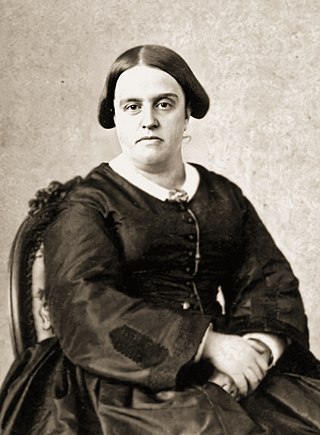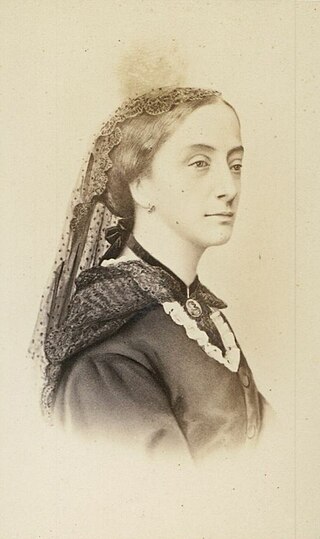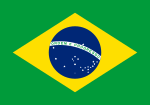
Manuel Deodoro da Fonseca was a Brazilian politician and military officer who served as the first president of Brazil. He was born in Alagoas in a military family, followed a military career, and became a national figure. Fonseca took office as provisional president after heading a military coup that deposed Emperor Pedro II and established the First Brazilian Republic in 1889, disestablishing the Empire. After his election in 1891, he stepped down the same year under great political pressure when he dissolved the National Congress. He died less than a year later.

Princess Januária of Brazil was a Brazilian princess and Portuguese infanta (princess). She was the second daughter of Pedro I of Brazil and IV of Portugal and his first wife, Archduchess Maria Leopoldina of Austria.

DonaFrancisca was a princess of the Empire of Brazil, who became Princess of Joinville upon marrying François d’Orléans, son of the French king Louis Philippe I. The couple had three children. Through their oldest daughter, Francisca and François are the ancestors of Jean, Count of Paris, the present Orléanist pretender to the French throne.

Dona Paula was a princess of the Empire of Brazil and thus, a member of the Brazilian branch of the Portuguese House of Braganza. Her parents were Emperor Dom Pedro I, the first ruler of an independent Brazil, and Archduchess Leopoldina of Austria. Born in Rio de Janeiro, Paula was the couple's fifth child and third daughter child; she lost her mother at the age of three and her father at the age of eight, when he abdicated and left Brazil for Portugal, where he wanted to restore the throne of Paula's eldest sister, Maria da Glória, who should have become queen regnant of Portugal.

The Imperial Order of Our Lord Jesus Christ, simply named Order of Christ, is an order of chivalry instituted by emperor Pedro I of Brazil on 7 December 1822, on the basis of the Portuguese Order of Christ founded by King Dom Dinis and Pope John XXII in 1316–1319.

Dom Afonso was the Prince Imperial and heir apparent to the throne of the Empire of Brazil. Born in Rio de Janeiro, he was the eldest child of Emperor Dom Pedro II and Dona Teresa Cristina of the Two Sicilies, and thus a member of the Brazilian branch of the House of Braganza.

The consolidation of Pedro II of Brazil covers the period from his coronation on 18 July 1841 until 6 September 1853.

The legacy of Pedro II of Brazil became apparent soon after his death. Emperor Pedro II was the second and last monarch of the Empire of Brazil, whose long 58-year reign (1831–1889) represented a time of remarkable prosperity and progress for his country. Despite his achievements, he was deposed in a coup by disgruntled republicans, though there was no desire for a change in the form of government among the majority of the Brazilian people.

Pedro II of Brazil was the second and last emperor of Brazil. Despite his popularity among Brazilians, Pedro II was removed from his throne in 1889 after a 58-year reign. He was promptly exiled with his family. Despite his deposition, he did not make an attempt to regain power. He died in late 1891 while in Paris, France, after two years in exile.

The decline and fall of Pedro II of Brazil took place in the 1880s. It coincided with a period of economic and social stability and progress for the Empire of Brazil, with the nation achieving a prominent place as an emerging power in the international arena.

The Apogee of Pedro II of Brazil refers to the decade from 1870 to 1881 during which Emperor Pedro II, and Brazil itself, reached the height of their prestige and activity. The nation experienced rapid development and the emperor was intimately involved in pushing for further progress on a variety of economic and cultural fronts. It was during this period that serious efforts toward the end of slavery began to be implemented.

In the life of Pedro II of Brazil, growth in both his personal and public roles took place in the decade beginning in 1853. At the start of this period, he was still struggling to find his way. But by its end the Emperor was a mature and steady leader, and Brazil was united and on its way to unprecedented national prosperity and prestige.

Dom Pedro Afonso was the Prince Imperial and heir apparent to the throne of the Empire of Brazil. Born at the Palace of São Cristóvão in Rio de Janeiro, he was the second son and youngest child of Emperor Dom Pedro II and Dona Teresa Cristina of the Two Sicilies, and thus a member of the Brazilian branch of the House of Braganza. Pedro Afonso was seen as vital to the future viability of the monarchy, which had been put in jeopardy by the death of his older brother Dom Afonso almost three years earlier.
The 1868 Brazilian political crisis led to the resignation of the ruling Progressive cabinet and the return of the Conservative Party to power in the Empire of Brazil.

Events in the year 1898 in Brazil.

Events in the year 1891 in Brazil.

Events in the year 1890 in Brazil.

The Liberal Rebellions of 1842 were a series of rebellions that took place in the Brazilian provinces of Minas Gerais and São Paulo in response to actions taken by emperor Dom Pedro II to unify power under the central government and limit the powers of the provinces. These rebellions were poorly coordinated and were put down by the central government to little effect. Along with the rebellions in Rio Grande do Sul, the Liberal Rebellions marked the end of a series of province-level rebellions that threatened the Empire of Brazil's stability.

Diretório Monárquico do Brasil was a monarchical institution established in Rio de Janeiro in 1890, one year after the proclamation of the republic, by Afonso Celso, Viscount of Ouro Preto, the last Prime Minister of the Empire of Brazil, entrusted by the former Princess Regent Isabel, to whom they considered Empress of Brazil after the death of her father Pedro II, in 1891, to organize the actions of Brazilian monarchists. The organization was constituted as an unofficial representation of the deposed heiress to the throne of Brazil and also functioned as a council.

The Black Guard of the Redemptress was a paramilitary secret society in Rio de Janeiro composed of Brazilian former African slaves freed on May 13, 1888, by the signature of the Golden Law by Isabel, Princess Imperial of Brazil.


















